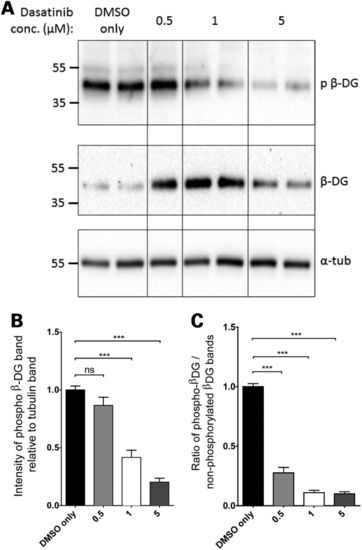
Phosphorylated β-dystroglycan in dasatinib-treated wild-type zebrafish larvae. Pools of 10 LWT zebrafish embryos were treated with dasatinib or DMSO from 24 hpf until 96 hpf and then lysed for SDS–PAGE. (A) A western blot of lysates probed with antibodies against phosphorylated β-dystroglycan (top panel), β-dystroglycan (middle panel) and α-tubulin (bottom panel). Numbers represent relative position of molecular weight markers in kDa. (B) The density of the blot probed against phosphorylated dystroglycan was quantified relative to α-tubulin levels in each sample, and represented as a ratio to the average DMSO only control signal. There is a significant decrease in the level of phosphorylated β-dystroglycan in dasatinib-treated embryos, compared with DMSO-treated controls. (C) The density of the blot probed against phosphorylated dystroglycan was quantified relative to non-phosphorylated dystroglycan levels in each sample, and normalized to the average DMSO only control signal. There is a significant decrease in the ratio of phosphorylated to non-phosphorylated dystroglycan in dasatinib-treated embryos, compared with DMSO-treated controls. Graphs show mean + SEM of at least eight samples for each treatment, from three independent experiments. One-way analysis of variance (ANOVA) was carried out followed by Dunnett′s multiple comparison test (ns, non-significant; ***P < 0.001).
|

